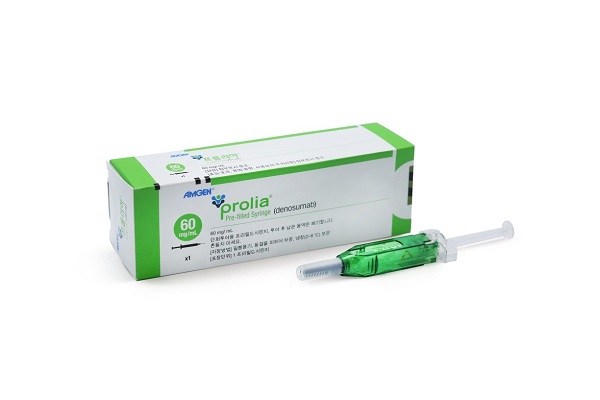AMGEN KOREA LAUNCHES PROLIA ® (DENOSUMAB), FIRST AND ONLY RANKL TARGETED OSTEOPOROSIS TREATMENT IN KOREA
Amgen Korea (GM: Noh Sang Kyung) launched Prolia® (denosumab), the first and only RANKL targeted treatment of osteoporosis,[i] in Korea. As the first and only biologics for treating osteoporosis by targeting RANKL, an essential protein for formation, function, survival of osteoclasts that destroys bone, Prolia is given as a single subcutaneous injection once every 6 months.1,[ii],[iii] It is indicated for the treatment of postmenopausal women with osteoporosis at high risk for fracture, treatment to increase bone density in men with osteoporosis, treatment of bone loss in patients with non-metastatic prostate cancer who are receiving androgen deprivation therapy, and treatment of bone loss in patients with breast cancer who are receiving aromatase inhibitor adjuvant therapy.3
As the most common metabolism disease, osteoporosis is a skeletal system disorder that is at risk for fracture as solidity of bone declines. It essentially needs treatment that can significantly reduce incidence of fractures at spine and non-spine sites and improve bone density as well as enhancing persistence.[iv]
The FREEDOM study, a phase III clinical trial with women in postmenopause, found that the group who received subcutaneous injection of denosumab for 3 years in every 6 months experienced reduction of risk in vertebral fracture, hip fracture and nonvertebral fracture by 68%, 40% and 20% respectively, compared to the placebo group. When the FREEDOM study was extended to 10 years, it continuously increased bone density without therapeutic plateau with low in incidence of vertebral fracture and nonvertebral fracture.[v], [vi] Also, the overall safety profile of denosumab in this extension study remains consistent over time, indicating a favorable balance between benefit and risk compared to placebo through 10 years of treatment.[vii]
In addition, patients who had previously received bisphosphonate and transitioned to Prolia demonstrated greater improvement in bone density than those who have consistently been treated with bisphosphonate,[viii], [ix], [x], [xi] Also, Prolia significantly improved persistence by being given subcutaneous injection in every 6 months.[xii]
“Osteoporosis is a silent disease with no symptoms until a fracture occurs, a potentially life-changing event for postmenopausal women and their families. We are excited to introduce a new effective and convenient treatment option to osteoporosis patients in Korea, where mortality risk is increasing due to osteoporotic fracture in an aging society, and there, remains unmet medical need,” said Dr. Sunyoung Yum, Medical Director for Amgen Korea.
Meanwhile, the American Academy of Clinical Endocrinology (AACE) recommends Prolia as a first-line treatment for moderate osteoporosis patients without fracture and severe osteoporosis patients with fracture.[xiii] U.S. National Osteoporosis Foundation (NOF) and Osteoporosis Australia also recommend Prolia as a first-line treatment for osteoporosis in their guidelines.[xiv], [xv]
Discovery of Prolia
Prolia emerged from the discovery of Amgen scientists in the company’s Genome Project in the 1980s. The discovery led to the identification of the RANK Ligand, an essential regulator of osteoclasts (the cells that break down bone), representing a significant advancement in the understanding of bone biology.
“At Amgen, we believe in a “biology first” approach through the use of cutting-edge science and technology to study the subtlest biological mechanisms in search of therapies that will improve the lives of those who suffer from diseases. With the introduction of Prolia, we are proud to be able to serve patients in Korea with our pioneering solutions,” said Dr. Yum.
[i] Korean Society for Bone and Mineral Research, Physician’s Guide for Diagnosis and Treatment of Osteoporosis, 2015, page 7, 132
[ii] Amgen Prolia® (denosumab) Prescribing Information, page 11
[iii] Prolia® Prefilled Syringe Product Information, page 1
[v] Cummings SR, et al. N Engl J Med. 2009 Aug 20;361(8):756-65, page 756
[vi] Bone HG et al. FREEDOM Extension 10-year ASBMR 2015
[vii] ASBMR; Seattle, WA; October 12, 2015; #LB-1157
[viii] Kendler DL, et al. J Bone Miner Res. 2010 Jan;25(1):72-81
[ix] Reckonr C, et al. Obstet Gunecol. 2013 Jun;121(6):1237-9
[x] Roux C, et al. Bone. 2014 Jan;58:48-54
[xi] Miller PD, et al. J Clin Endocrinol Metab. 2016 Aug;101(8):3163-70
[xii] Freemantle N, et al. Osteoporos Int. 2012 Jan;23(1):317-26
[xiii] AACE, Medical Guidelines for Clinical Practice for the Diagnosis and Treatment of Postmentopausal Osteoporosis, 2010, page 5, 19
[xiv] Washington State Health Care Authority, Denosumab Medical Policy, June 2016, page 6


